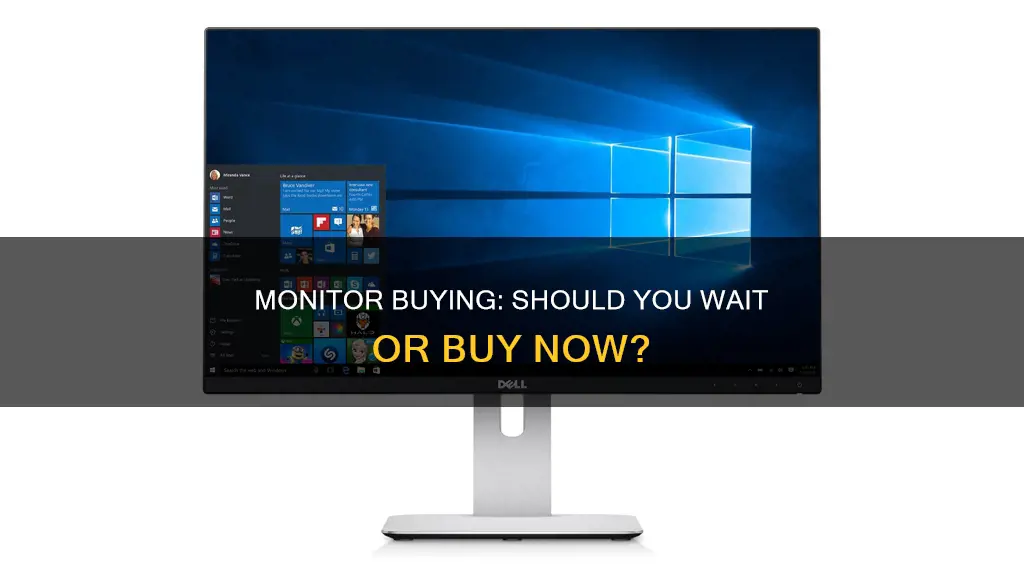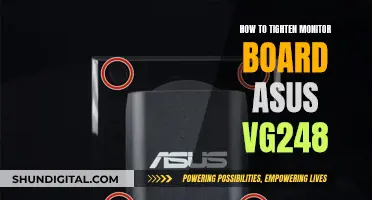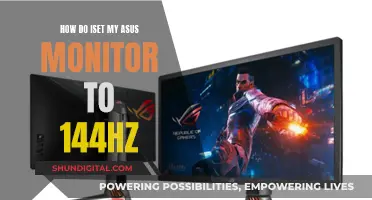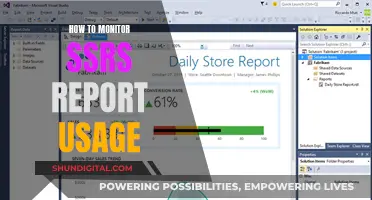
If you're looking to buy a new monitor, there are a few things you might want to consider before making your purchase. Firstly, it's important to identify your needs and budget. Do you require specific features such as a certain resolution, refresh rate, or panel type? Additionally, certain times of the year, like Black Friday and the Christmas holidays, tend to offer better deals on monitors. If you can wait, holding off on your purchase until these sales periods may help you save some money. It's also worth noting that manufacturers often release new series of monitors, which can cause the previous series to drop in price. However, the decision to buy now or wait ultimately depends on your specific circumstances and preferences.
| Characteristics | Values |
|---|---|
| When to buy a monitor | Black Friday, Cyber Monday, Christmas holidays, January, February, July (Prime Day), September (Labor Day) |
| Monitor specifications to consider | Screen resolution, contrast ratio, response time, refresh rates, viewing angle, ergonomic stand adjustment, panel technologies, video input & output connections |
| Panel technologies | Twisted Nematic (TN), Vertical Alignment (VA), In-plane Switching (IPS), Organic light-emitting diode (OLED) |
| Video input & output connections | DVI-I, DVI-D, HDMI, DisplayPort, VGA |
What You'll Learn

Should I wait for the next Black Friday deal?
If you're looking to buy a monitor, Black Friday is the best time to score the best deals, followed by Cyber Monday. If you've missed the annual sale, there are still some parts of the year that are better for shopping for monitors.
You may want to hold off on buying a new monitor until the Christmas holidays if you wish to get a better deal. January and February are also favourable months for picking up a new monitor, as most manufacturers are restocking their supplies at that time and will likely lower the prices to get rid of old inventory.
If you're an Amazon Prime member, you can also find some exciting deals during Prime Day, which takes place in July. A lot of monitors will go on sale during this time even for non-Prime members.
If you're looking for a specific type of monitor, you may want to consider waiting for newer models to be released. For example, if you're interested in a monitor with HDR, it might be worth waiting until the updated model comes out.
Additionally, if you're open to alternatives, you may want to consider getting an older version of the monitor or a refurbished product. When a monitor manufacturer releases a new series, the previous series is likely to drop in price. However, buying a refurbished monitor comes with a few risks, such as a shorter warranty and the possibility of receiving a display with dead or stuck pixels.
In summary, if you're looking for a great deal on a monitor, waiting for the next Black Friday sale is a good idea. However, if you can't wait that long, there are still plenty of other opportunities throughout the year to find discounts on monitors.
Utilizing AMD GPU Potential: Dual Monitor Setup Guide
You may want to see also

What are the best times of year to buy a monitor?
If you're looking to buy a new monitor, there are certain times of the year when you can get a better deal.
Black Friday is the best time to find discounts, followed by Cyber Monday. If you miss these, then the Christmas holidays, January and February are good times to buy as manufacturers restock their supplies and lower prices to get rid of old inventory. Late January is ideal for shopping for TVs due to the Super Bowl, so you might find some good monitor deals too.
You might also find some good deals during the 'back to school' period, which runs from mid-July to mid-September, including Labor Day. During this time, school and office-related supplies, including certain monitors, go on sale. If you're an Amazon Prime member, you can also find deals during Prime Day (July 11-12).
If you're looking to buy a monitor, it's also worth considering getting an older version of the monitor or a refurbished product. When a manufacturer releases a new series, the previous series often drops in price.
Monitoring Virtual Memory Usage: A Comprehensive Guide
You may want to see also

What specs should I look for?
When shopping for a monitor, the specs you should look for depend on how you plan to use it. If you're a gamer, your priorities will be different from those of a professional photographer or general user.
Monitor Types
There are four main types of monitors: TN (twisted nematic), IPS (in-plane switching), VA (vertical alignment), and OLED (organic light-emitting diode).
- TN panels are known for their fast pixel response times, which is important for gamers, but they have limitations in contrast and colour performance.
- IPS panels offer good sharpness, viewing angles, and colour performance, but they have disappointing contrast and black levels, which can make dark images appear hazy in a dark room.
- VA panels provide excellent contrast and image depth, with brighter and more colourful images than IPS panels, but their viewing angles are more limited, so the image quality can degrade if not viewed straight-on.
- OLED panels offer the best contrast and black levels, as well as excellent motion clarity and viewing angles, but they are very expensive.
Monitor Size
Monitor size is a matter of personal preference. Most monitors are 24-inch, 27-inch, or 32-inch widescreens. A 27-inch monitor is a common choice, but bigger sizes are preferable for certain activities, such as gaming or professional photo and video editing.
Monitor Resolution
The most common monitor resolutions are 1080p (1920x1080), 1440p (2560x1440, also known as QHD or WQHD), and 4K (3840x2160, also called UHD). 1080p is the minimum resolution you need, but higher resolutions like QHD and 4K offer sharper images, which are ideal for larger monitors used for gaming or photo/video editing.
Monitor Refresh Rate and Response Time
The refresh rate is the number of times a monitor updates with new information per second, measured in hertz (Hz). A higher refresh rate means smoother, less choppy images, which is especially important for gamers. Most monitors have a 60Hz refresh rate, but gamers should look for a monitor with at least 75Hz, preferably 120Hz or higher.
Response time refers to how long it takes for a monitor to change individual pixels from black to white or between shades of grey. A shorter response time is better, especially for gaming, as longer response times can lead to motion blur when gaming or watching fast-paced videos. For gaming monitors, look for a response time of 5ms or lower.
Other Features
Other specs to consider include:
- Brightness level: If you'll be using your monitor in a sunny or brightly lit room, look for a brightness level of 350 cd/m2 or higher.
- Contrast ratio: This is the difference between the screen's whitest white and deepest black. A higher contrast ratio means better image quality.
- Adaptive sync: This feature synchronizes a PC's video output with the monitor's refresh rate to provide perfect frame pacing. AMD FreeSync and Nvidia G-Sync are common standards that work with their respective graphics cards.
- Monitor stand: Look for a stand that is adjustable for height and tilt, and consider whether you need swivel and pivot functionality as well.
- Monitor HDR: Only consider this if you're opting for an OLED or Mini-LED monitor, as these are the only types that can deliver a high-quality HDR experience.
- Connections: Most computer monitors have HDMI, but for very high resolutions and frame rates, DisplayPort connectors are the best choice.
- USB-C: This allows you to charge connected devices or use the monitor as a USB-C hub.
- Blue light reduction: This feature reduces the amount of blue light emitted by the display, which is supposed to make it less stimulating and more relaxing to look at.
- Curvature: Curved monitors are supposed to provide a more immersive experience and reduce eye strain, but they can be prone to glare when viewed from certain angles.
- Additional features: Built-in webcams, speakers, dual-monitor stands, and ergonomic features like tilt and swivel functionality can also be important, depending on your intended use.
Monitor Size: Does Scale Impact Studio Performance?
You may want to see also

What type of panel is best?
There are four main types of monitor panels: TN (Twisted Nematic), VA (Vertical Alignment), IPS (In-Plane Switching), and OLED (Organic Light-Emitting Diode). Each has its own advantages and is suited to different needs and budgets.
TN Panels
TN panels are the oldest and most affordable type. They offer very fast response times and high brightness, making them a good choice for gaming, especially in bright rooms. However, they have limited viewing angles and don't offer the best colour reproduction or deep black levels.
VA Panels
VA panels improve upon TN technology by offering better black levels and contrast, making them a good choice for HDR content. They also have wider viewing angles and improved colour reproduction compared to TN panels. VA panels are a good middle ground between TN and IPS panels, offering a balance of performance and image quality.
IPS Panels
IPS panels are known for their excellent viewing angles and rich, varied colours. They also have good response times and can support high refresh rates, making them a popular choice for gaming. However, they can struggle with dark scenes and have lower contrast than VA panels.
OLED Panels
OLED panels use a completely different technology compared to the other three types, offering true black levels, excellent viewing angles, and vibrant colours. They also have extremely fast response times. However, they are more expensive and can suffer from permanent image retention over time.
The best panel type depends on your specific needs and budget. If you want the fastest response times and don't mind sacrificing colour accuracy, TN panels are a good choice. If you want a balance of performance and image quality, VA panels are a great option. If you prioritise colour accuracy and viewing angles, IPS panels are ideal. Finally, if you want the best image quality and don't mind the higher cost, OLED panels are the way to go.
Freesync and 144Hz Monitors: Worth the Investment?
You may want to see also

What video input and output connections are best?
When it comes to video input and output connections, there are several options to choose from, each with its own advantages and use cases. Here is a detailed guide to help you understand the best connections for your needs:
HDMI (High-Definition Multimedia Interface): HDMI is the most widely used connector for monitors, PCs, laptops, and smart TVs. It supports both audio and video signals, delivering great sound and video quality. HDMI has been the industry standard since its introduction in 2002 and is supported by most devices. It uses a 19-pin connector and offers superior resolution compared to older connections like VGA.
DisplayPort: DisplayPort is a more versatile and specialised alternative to HDMI. It is highly regarded for its audio and video quality and is often preferred by users who frequently work with video. DisplayPort comes in different versions, such as DP 1.2, 1.3, and 1.4, supporting various resolutions and refresh rates, including 4K and 8K video output. It can achieve a refresh rate of 144Hz, making it an excellent choice for gaming setups as well.
DVI (Digital Visual Interface): DVI is an older connection found on slightly older PCs. While it doesn't carry audio, DVI offers a higher frame rate than HDMI for 1080p monitors. It transmits pure digital signals, resulting in sharper image quality. DVI is a good choice for gamers who prioritise crisp visuals. DVI can also be easily converted to HDMI, making it versatile.
VGA: The Video Graphics Array (VGA) port is an older connection that predates HDMI and is gradually becoming less common. It is primarily used to connect older devices that rely on analogue audiovisual signals. VGA is recognisable by its 15-pin connector with 5 pins in three rows. While it is widely available, VGA may not deliver the same video quality as newer connections.
USB-C and Thunderbolt: USB-C is a versatile connector that can be used as a substitute for HDMI or DisplayPort. One of its key advantages is its reversibility, simplifying setups with multiple screens. USB-C is found on newer laptops, smartphones, and tablets, connecting a wide range of devices. Thunderbolt, developed by Intel in collaboration with Apple, acts as USB-C for Apple device users, offering similar versatility.
SDI (Serial Digital Interface): SDI is commonly used in the motion picture industry and is ideal for transmitting digital video signals over long distances, up to 300 meters. It is also used in CCTV and video security camera setups.
AV (RCA): AV (RCA) input holds historical significance and was once popular for connecting video game consoles and electronic devices to televisions or displays. It serves as the gateway for analogue audiovisual signals, converting them into AV signals for display output.
NDI (Network Device Interface): NDI uses ethernet networking to transmit audio and video, enabling users on the same network to seamlessly share content. This technology has been adopted by many offices for presentations and meetings.
In summary, the best video input and output connections depend on your specific needs. HDMI remains the industry standard for its versatility and multimedia capabilities, while DisplayPort excels in performance and data transfer rate, supporting 4K and 8K video output. DVI is a good choice for gamers seeking high refresh rates, and VGA serves as a legacy connection for older devices. USB-C and Thunderbolt offer versatility in connecting a wide range of devices, and specialised connections like SDI, AV (RCA), and NDI cater to specific use cases.
CenturyLink Internet Usage: Monitor, Track, and Manage Your Data
You may want to see also
Frequently asked questions
If you want to get the newest features, it may be worth waiting to see what new monitors are released. However, if you are looking for a good deal, it may be better to buy an older model or a refurbished product, as prices tend to drop when new series are released. Additionally, January and February are favourable months for purchasing monitors, as manufacturers are restocking their supplies and often lower prices to get rid of old inventory.
It depends on your specific needs and preferences. If you are looking for a particular set of features, it may be worth waiting for newer models to be released. On the other hand, if you are satisfied with the current offerings and want to take advantage of deals, it may be better to purchase now during sales periods or when manufacturers are clearing out old inventory.
Some key specifications to consider include screen resolution, contrast ratio, response time, refresh rate, viewing angle, panel technology, and video input/output connections. It's also important to ensure that your PC can handle the resolution and refresh rate of the monitor you plan to purchase.







